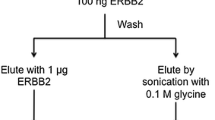Abstract
The ErbB-2 receptor, a member of the tyrosine kinase type 1 family of receptors, has been implicated in many human malignancies. The overexpression of ErbB-2 in cancer cells as well as its extracellular accessibility makes it an attractive target for the development of tumor-specific agents. In this study, random peptide bacteriophage display technology was employed to identify peptides that bound the extracellular domain of human ErbB-2. The peptide KCCYSL, most frequently occurring in the affinity-selected phage population, was chemically synthesized and characterized for its binding activities to ErbB-2. The synthetic peptide exhibited high specificity for ErbB-2 and an equilibrium dissociation constant of 30 μM. Peptide binding to ErbB-2 positive human breast and prostate carcinoma cells was visualized in direct cell binding assays. In conclusion, the peptide KCCYSL has the potential to be developed into a cancer imaging or therapeutic agent targeting malignant cells overexpressing the ErbB-2 receptor.
Similar content being viewed by others
REFERENCES
Ballinger, M. D., Jones, J. T., Lofgren, J. A., Fairbrother, W. J., Akita, R. W., Sliwkowski, M. X., and Wells, J. A. (1998). J. Biol. Chem. 273:19, 11675-11684.
Baselga, J., Norton, L., Albanell, J., Kim, Y-M., and Mendelson, J. (1998). Cancer Res. 58, 2825-2831.
Clark, M. A., Hawkins, N. J., Papaionnou, A., Fiddes, R. J., and Ward, R. L. (1997). Clin. Exp. Immunol. 109, 166-174.
De Potter, C. R., Daele, S. V., Van De Vijver, M. J., Pauwels, C., Maertens, G., De Boever, J., Vanderkerckhove, D., and Roels, H. (1989). Histopathology 15, 351-362.
Devlin, J. J., Panganiban, L. C., and Devlin, P. E. (1990). Science 249, 404-406.
Disis, M. L., Grabstein, K. H., Sleath, P. R., and Cheever, M. A. (1999). Clin. Cancer Res. 5:6, 1289-1297.
Dono, R., Montuori, N., Rocchi, M., De Ponti-Zilli, L., Ciccodicola, A., and Persico, M. G. (1991). Am. J. Human Genet. 49:3, 555-565.
Doorbar, J. and Winter, G. (1994). J. Mol. Biol. 244:4, 361-369.
Fischman, A. J., Babich, J. W., and Strauss, H. W. (1993). J. Nucl. Med. 34:12, 2253-2263.
George, D. G., Barker, W. C., Mewes, H. W., Pfeiffer, F., and Tsigita, A. (1996). Nucl. Acids Res. 24, 17-20.
Giebel, L. B., Cass, R. T., Milligan, D. L., Young, D. C., Arze, R., and Johnson C. R. (1995). Biochemistry 34, 15430-15435.
Haas, S. L. and Smith, G. P. (1993). Biotechniques 15, 422-424.
Harris, J. D., Gutierrez, A. A., Hurst, H. C., Sikora, K., and Lemoine, N. R. (1994). Gene Ther. 1:3, 170-175.
Houimel, M., Schneider, P., Terskikh, A., and Mach, J. P. (2001). Int. J. Cancer 92, 748-755.
Hynes, N. E. and Stern, D. F. (1994). Biochim. Biophys. Acta 1198, 165-184.
Jinno, H., Ueda M., Enomoto, K., Ikeda, T., Kyriakos, P., and Kitajima, M. (1996). Surg. Today 26:7, 501-507.
Jones, J. T., Akita, R. W., and Sliwkowski, M. X. (1999). FEBS Lett. 447, 227-231.
Kay, B. K., Adey, N. B., He, Y. S., Manfredi, J. P., Mataragnon, A. H., and Fowlkes, D. M. (1993). Gene 128, 59-65.
Masuko, T., Sugahara, K., Kozono, M., Otsuki, S., Akiyama, T., Yamamoto, T., Toyoshima, K., and Hashimoto, Y. (1989). Jpn. J. Cancer Res. 80, 10-14.
McInnes, C. and Sykes, B. D. (1997). Biopolymers 43:5, 339-366.
Murayama O., Nishida H., and Sekiguchi K. (1996). J. Biochem. (Tokyo) 120:2, 445-451.
Oldenburg, K. R., Loganathan, D., Goldstein, I. J., Schultz, P. G., and Gallop, M. A. (1992). Proc. Natl. Acad. Sci. 89, 5393-5397.
Pearson, W. R. and Lipman, D. J. (1988). Proc. Natl. Acad. Sci. 85:8, 2444-2448.
Peletskaya, E. N., Glinsky, G. V., Deutscher, S. L., and Quinn, T. P. (1996). Mol. Diversity 2, 13-18.
Peletskaya, E. N., Glynsky, V. V., Glinsky, G. V., Deutscher, S. L., and Quinn, T. P. (1997). J. Mol. Biol. 270, 374-384.
Piccart, M. J., Awada, A., and Hamilton, A. (1999). In American Society of Clinical Oncology Educational Book, Perry, M. C., ed., 1999 American Society of Clinical Oncology, Alexandria, VA.
Renschler, M. F., Wada, H. G., Fok, K. S., and Levy, R. (1995). Cancer Res. 55:23, 5642-5647.
Scott, J. K. and Smith, G. P. (1990). Science 249, 386-390.
Smith, G. P. and Scott, J. K. (1993). Meth. Enzymol. 217, 228-257.
Stoesser, G., Tuli, M. A., Lopez, R., and Sterk P. (1999). Nucl. Acids Res. 27:1, 18-24.
Strong, J. E. and Lee, P. W. (1996). J. Virol. 70, 612-616.
Tang, D., Strong, J. E., and Lee, P. W. (1993). Virology 197, 412-414.
Taupin, D., Deng-Chyang Wu, Woo-Kyu Jeon, Devaney, K., Wang, T. C., and Podolsky, D. K. (1999). J. Clin. Invest. 103, R31-R38.
Weiner, L. M., Clark, J. I., Davey, M., Li, W. S., Garcia de Palazzo I., Ring, D. B., and Alpaugh, R. K. (1995). Cancer Res. 55:20, 4586-4593.
Wienchen, K. and Dietel M. (1995). Int. J. Cancer 63:4, 604-608.
Wrighton, N. C., Farrel, F. X., Chang, R., Kashyap, A. K., and Barbone, F. P., et al. (1996). Science 273, 458-463.
Wu, J. T., Astill, M. E., and Zhang, P. (1993). J. Clin. Lab. Anal. 7, 31-40.
Yarden, Y. (1990). Proc. Natl. Acad. Sci. U.S.A. 87, 2569-2573.
Zhau, H. E., Wan, D. S., Zhou, J., Miller, G. J., and von Eschenbach, A. C. (1992). Mol. Carcinogenesis 5:4, 320-327.
Author information
Authors and Affiliations
Corresponding author
Rights and permissions
About this article
Cite this article
Karasseva, N.G., Glinsky, V.V., Chen, N.X. et al. Identification and Characterization of Peptides That Bind Human ErbB-2 Selected from a Bacteriophage Display Library. J Protein Chem 21, 287–296 (2002). https://doi.org/10.1023/A:1019749504418
Published:
Issue Date:
DOI: https://doi.org/10.1023/A:1019749504418




